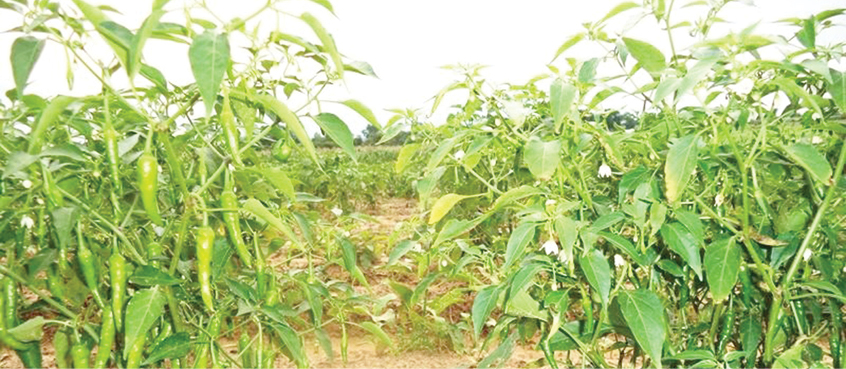AGRO SOLUTIONS: Are your pepper plants not growing as expected?
Slow or stunted growth happens to peppers sometimes, but there are methods to fix it. We have put together our top tips for when your pepper plants are not growing. The first few tips in this article will pertain to younger plants, while the later tips apply to more mature pepper plants. However, we recommend […]

A pepper farm
Slow or stunted growth happens to peppers sometimes, but there are methods to fix it. We have put together our top tips for when your pepper plants are not growing.
The first few tips in this article will pertain to younger plants, while the later tips apply to more mature pepper plants. However, we recommend reading all of these causes to ensure that you take preventative measures next season!
All of these methods are part of basic pepper plant care. Your routine may simply need one adjustment to get your pepper plants to start growing normally again. For each possible cause, we’ll cover some other symptoms you will likely see in addition to slowed or stopped plant growth.
Fertilize regularly (but not too much)
Once pepper seeds sprout, they will start to use nutrients. They don’t need much at first, but as they grow larger, they will use more and more.
- Time to reclaim Nigeria’s position in Africa and the world
- Will Rivers United swallow ‘elephants’ to retain league title?
Depending on the stage of growth, the type and quantity of fertilizer you use will vary. For young plants four weeks or younger, we recommend 1/2 strength nitrogen-rich fertilizer. Alternatively, you could use a nutrient-rich potting soil without fertilizing at all.
For plants that are beginning to produce flowers and fruits, we recommend switching to a phosphorus-rich fertilizer and reducing nitrogen. This encourages the plant to stop growing new leaves and focus on producing peppers.
Other symptoms of nutrient issues: Yellowing leaves, leaves wilting or falling off and flowers dropping
Note: If you use a nutrient-rich soil, then fertilizer is likely unnecessary for the first 2-3 months of growth.
If your pepper plants are not growing, consider your fertilizer regimen and adjust if necessary. If you are fertilizing consistently or have healthy soil, look to other possible causes.
Remove early flowers and peppers
One of the most common causes of smaller peppers is leaving early fruits to form. During the first few weeks of outdoor growth, you should pick off flowers and fruits.
This helps the plant direct more energy into growing roots, branches, and foliage. The early growth translates to a larger harvest later in the season.
It can be tempting to leave an early bell pepper on your plants for a quick harvest. However, this will only set your plants back and cause them to perform poorly overall.
We typically recommend picking any flowers or young fruits until the plants have been outside in their permanent location for 2-3 weeks. After that, leave the flowers on to grow and produce fruits!
Transplant shock
Transplanting is a necessary step in growing peppers from seed. Shortly after transplanting seedlings into larger pots or into the ground, the plants may grow more slowly for several weeks.
This is normal. When peppers move to a larger body of soil, the root systems need some time to adjust and grow into the new surroundings. Be patient and allow the plant to recover and establish itself without too much disturbance. We also recommend avoiding fertilizing for the first 1-2 weeks after transplanting.
Sun shock is a related issue that can occur when transplanting peppers to the outdoors for the first time. Direct sunlight is much more intense than grow lights, and pepper plants must be hardened off gradually to avoid damage.
Other signs of transplant shock: Leaf drop and curling or abnormal leaves forming.
Most important is to be patient after transplanting while the plant gets established. More often than not, the plants integrate within a couple weeks or so, and then take off in growth!
Pull weeds regularly
This may seem obvious, but weeds can inhibit your pepper plant’s ability to grow. While weeding is a chore, it is important to avoid your peppers from competing with unwanted plants. Weeds can also be a breeding ground for unwanted pests.
Pull weeds when they are small to prevent large, nutrient-stealing root systems. Alternatively, lay down a mulch cover around the base of your peppers, such as chopped straw or a black tarp. This will prevent weeds from growing in the first place.
Check for pests
Pests can be a nightmare for any type of garden plant. Peppers are vulnerable to aphids, spider mites, thrips, grasshoppers, slugs, caterpillars, and many others.
When pepper plants are under attack, they can often slow or stop growing. However, there are some tell-tale signs of insect damage.
Other signs of pest damage: Curled leaves, Holes in leaves or peppers, Random brown spotting on leaves, Bite marks in leaves (usually caterpillars or slugs) Live pests (look closely and under leaves).
Disease
Unfortunately, pepper plants are susceptible to a variety of diseases as well as pests. Most will cause visible signs of infection and distress.
Diseases can often mean that your pepper plant must be discarded. Most can spread easily from one plant to another, and many can lay dormant in soil or seeds, infecting future crops.
To avoid disease, always be sanitary while in the garden. We also recommend bottom pruning pepper branches to keep leaves up and away from the soil. Never water over the top of your plants, always just at the base of the main stem.
Many diseases are spread via pests as well, so be sure to control your pests in addition to bottom pruning and mulching.
SOURCE: Pepper Geek
